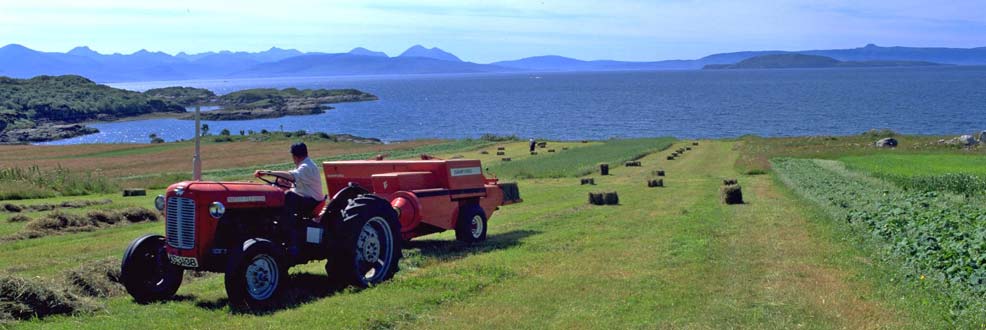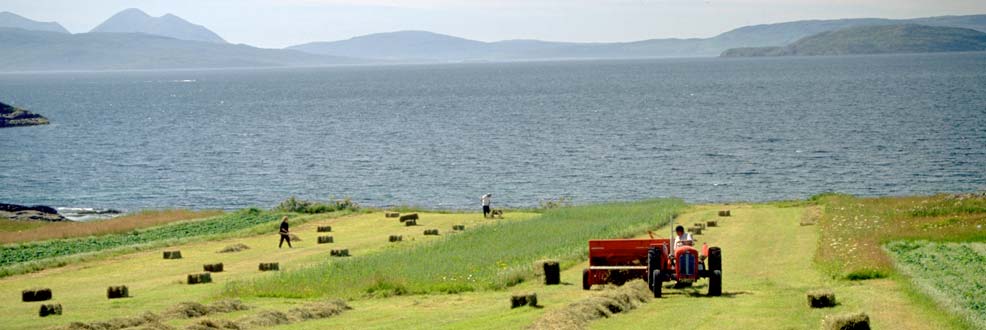Regulation
The current system of crofting has evolved through a number of Crofting Acts and Reforms that were initiated by the original Crofters Act of 1886 that arose as a result of the Napier Commission (1883). The history of these developments are outlined in Angus MacLeod's Archive 'An Overview of the History of Crofting'.
One definition of crofting that was proposed in the Inquiry on Crofting, 2008, was: ‘a smallholding entirely surrounded by regulations’. In the same document, the role of regulation in crofting was expressed as: ‘Crofting was created by regulation, it has survived and developed by regulation and its very existence can only be perpetuated by regulation.’
Crofting therefore carries a heavy burden of regulation covering every aspect of crofting activity.
The body responsible for regulation is the Scottish Government’s department known as the Crofting Commission.
Forms and guidance:
• Assignation
• Subletting
• Apportionment
• Change of ownership
• Change of contact details
• Crofters Duties
• Creating a new croft
• Crofter Forestry
• Decrofting
• Division
• Enlarging croft land
• Exchange of croft land
• Letting
• Succession
• Short Term Let
• Renunciation of a croft tenancy
• Resumption
Received Applications and Decisions/Notifications by the Crofting Commission can be accessed here.
All appeals made to the Scottish Land Court regarding decisions made by the Crofting Commission can be accessed here.
Invasive Species
There are a number of harmful 'weeds' that you must prevent from spreading from your land onto a neighbour's property:
- common ragwort
- spear thistle
- creeping or field thistle
- broad-leaved dock
- curled dock
You might have to follow the rules of an enforcement notice if you allow these weeds to spread onto someone else’s property. You can also be prosecuted if you allow animals to suffer by eating these weeds.
You must not plant in the wild or cause certain invasive and non-native plants to grow in the wild. This can include moving contaminated soil or plant cuttings. You can be fined or sent to prison for up to 2 years.
The most commonly found invasive, non-native plants include:
- Japanese knotweed
- giant hogweed
- Himalayan balsam
- Rhododendron ponticum
- New Zealand pigmyweed (this is banned from sale)
Advice about how to identify and to control these species, particularly ragwort, the most common, is provided by the UK Government.
The Invasive Species and Biosecurity Programme (Scotland) provides further information for both terrestrial and aquatic plants as well as for invertebrate and vertebrate invasive-non native species. 'Invasive non-native species and fish diseases damage our environment, the economy, our health and the way we live. We need your support to increase awareness and better understanding of Invasive Non Native Species and Biosecurity issues and impacts and what can be done about them.'
Species profiles and information on management measures for each of the following species is provided.
Terrestrial plants
- Rhododendron (Rhododendron ponticum & hybrids)
- Japanese Knotweed (Fallopia japonica)
- Himalayan Balsam (Impatiens glandulifera)
- Giant Hogweed (Heracleum mantegazzianum)
- Common Cord-grass (Spartina anglica)
Aquatic plants
- Water Primrose (Ludwigia grandiflora)
- Fanwort (Cabomba caroliniana)
- Large Flowered Waterweed (Egeria densa)
- Floating Pennywort (Hydrocotyle ranunculoides)
- Australian Swamp Stonecrop (Crassula helmsii)
- Parrot’s Feather (Myriophyllum aquaticum)
- Water Fern (Azolla filiculoides)
- Nuttall’s Pondweed (Elodea nutallii)
- Canadian Pondweed (Elodea canadensis)
- Curly Waterweed (Lagarosiphon major)
- Wireweed (Sargassum muticum)
Invertebrates
- Gyrodactylus salaris
- North American Signal Crayfish (Pacifastacus leniusculus)
- Zebra Mussel (Dreissena polymorpha).
- Chinese Mitten Crab (Eriocheir sinensis).
- Slipper Limpet (Crepidula fornicata)
- Didemnum Tunicates / Sea Squirts (Didemnum vexillum)
Vertebrates
- American Mink (Mustela vison)
- Asian Topmouth Gudgeon (Pseudorasbora parva)
- Ruddy Duck (Oxyura jamaicensis)
- Minnows (Phoxinus phoxinus)
- Ruffe (Gymnocephalus cernuus)
- Orfe (Leuciscus idus)
- Bullhead (Cotus gobio)











